A large constellation of the southern sky, the bulk of which rises above the horizon in our latitudes during the winter and spring months. The stern lies south of Procyon, below the Monoceros. It is bounded on the west by the Canis Major, on the east by the constellation of Compass, and can be observed entirely from the Mediterranean regions. The stern lies east and southeast of the Canis Major and the Milky Way passes through it. Because the dust clouds are relatively diffuse in this direction across the plane of our Galaxy, we can see outward to the galactic edge for long distances. As a result, the Puppis is very rich in diverse open clusters whose shape is very different at first glance. Some are very large and relaxed, more suitable for a binocular, some are relatively large and very rich and suitable for a small telescope, and some are faint and distant, requiring a larger telescope to see them better. The brightest of these is M47, easily visible to the naked eye as a hazy patch to the east of Sirius, next to another cluster, M46.
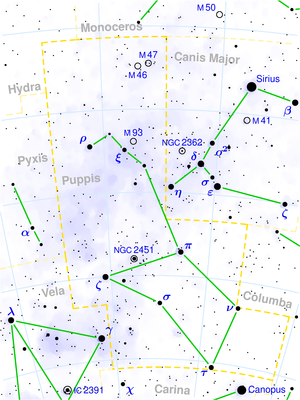 From the open cluster M93 (an inconspicuous fogspot), a bright, bright Milky Way belt stretches towards the interface of the Puppis, Vela and Compass. The first brightening is in the north of M93, around the stars ξ and ο Pupp. The next one, slightly larger and brighter, is in the southern part, where a number of faint purchased stars can be seen. The clusters Collinder 121 and 132 appear to be merely rich star field densifications. To the west of the bright Milky Way belt is a fairly conspicuous dark region that continues on into the constellation Vela and breaks up there. The area around the bright star π Puppy (2.7mag) looks very hazy and spotty. It is the brightest member of the large and poorly condensed open cluster Collinder 135, which is made up of 30 stars of a wide range of magnitudes in an area of one degree. At the northern boundary of the cluster lies a trio of bright fifth-magnitude blue stars. An even more striking brightening is found above the conjunction of the stars π and ζ Pupp. Individual stars also emerge from it. The brightest of these, the orange c Puppy (3.7mag), is part of the bright and relaxed cluster NGC 2451. In its vicinity lies another remarkable open cluster, NGC 2477 (5.7mag), very similar to M46 or NGC 7789 of Cassiopeia.
From the open cluster M93 (an inconspicuous fogspot), a bright, bright Milky Way belt stretches towards the interface of the Puppis, Vela and Compass. The first brightening is in the north of M93, around the stars ξ and ο Pupp. The next one, slightly larger and brighter, is in the southern part, where a number of faint purchased stars can be seen. The clusters Collinder 121 and 132 appear to be merely rich star field densifications. To the west of the bright Milky Way belt is a fairly conspicuous dark region that continues on into the constellation Vela and breaks up there. The area around the bright star π Puppy (2.7mag) looks very hazy and spotty. It is the brightest member of the large and poorly condensed open cluster Collinder 135, which is made up of 30 stars of a wide range of magnitudes in an area of one degree. At the northern boundary of the cluster lies a trio of bright fifth-magnitude blue stars. An even more striking brightening is found above the conjunction of the stars π and ζ Pupp. Individual stars also emerge from it. The brightest of these, the orange c Puppy (3.7mag), is part of the bright and relaxed cluster NGC 2451. In its vicinity lies another remarkable open cluster, NGC 2477 (5.7mag), very similar to M46 or NGC 7789 of Cassiopeia.
Naos (ζ Puppis) - Because the Argo Navis was originally considered as one constellation, the method of labeling stars with Greek letters is the same for all its divided parts. Therefore, in the Stern, we will not find any alpha, beta, gamma, or delta Puppis, the brightest star is ζ Puppis, which reaches a magnitude of 2.3.
ν Pup - An easily distinguishable double star is located just 26' NE of σ Puppis. The components of this pair have magnitudes of 4.7 and 5.1, with a separation of 4'.
σ Pup - A nice double star, distinguishable already with a 5 cm telescope. The main orange component has a brightness of 3.3 mag and its yellow companion at a separation of 22.3" reaches only 9.4 mag.
L2 Puppis - A clear long-period variable star belonging to the Mirid group, one of the brightest red variable stars, whose brightness varies between 2.6mag and 6.2mag in a period of 141 days. In its maximum, it is therefore very well visible even from illuminated areas, but in its minimum, it drops to the limit of visibility with the naked eye.
Struve 1104 - A beautiful, but tight pair of golden yellow stars, which however requires good seeing for clear resolution. The brightness components of 6.4mag and 7.5mag are separated by 2.1".
NGC 2467
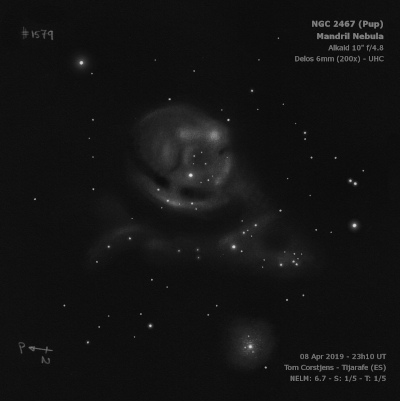
William Herschel discovered NGC 2467 = H IV-22 = h472 on 9 Dec 1784 (sweep 333) and recorded (two observations combined) "L, pB, almost R, easily resolvable, 6 to 10' diameter, a faint red colour visible. A star 8 mag not far from the center, but they evidently have no connection together. By second observation, 9 or 10' diameter." John Herschel observed it on 7 Jan 1831 (sweep 317) and wrote, "a * 9th mag with a W of stars and nebulosity, or ? is not a vF neb about the stars - no red colour seen."
Joseph Turner sketched NGC 2467 on 13 Jan 1877 with the Great Melbourne Telescope (p. 129 on his logbook, unpublished Plate V, figure 45) as an oval shaped nebula to the south of the bright star and brightest along the western side. See Harold Corwin's identification notes for more.
200/250mm - 8" (3/24/84): fairly bright, moderately large, roughly circular. A mag 8 star is north of center. This is a prominent nebulosity even with this aperture.
300/350mm - 13.1" (1/30/06 - Costa Rica): bright, large nebulosity at 75x using an OIII filter, ~4-5' diameter, surrounding a mag 8 star (O6-O7V star HD 64315, the ionization source). The main section is roughly mushroom shaped, extending generally south of the bright star. The southern border is locally brighter along a strip oriented NW to SE. There is a sharp light cut-off (apparently due to dust) passing to the north of the central star and oriented E-W. Faint haze extends ~15' to the east. To the north, fainter nebulosity extends 12' E-W, and brightens towards the east end at an elongated group of brighter stars (Haffner 18), oriented NW-SE. Removing the filter, NGC 2467 resides in a gorgeous low power Milky Way field with numerous faint stars peppering the region.
400/500mm - 17.5" (3/2/02): Using a 31 Nagler at 64x and an OIII filter, this is a prominent 7' nebulosity surrounding a mag 8 star. A dark lane appears to cut through the nebula from west to east starting NW of the central star. Fainter nebulosity extends beyond the dark lane but then fades out to the north. The south and southeast border of the main mass has a bright, distinct edge and the southern border has a small extension on the west edge which hooks towards the NW.
A finger of nebulosity extends north from the main body and involves a scattered group of brighter stars. This strip dims but nearly merges with a much larger, elongated mass of fairly faint nebulosity extending NW to SE at a roughly right angle. This section is ~15' in size with an irregular border that is bounded on the NE side by a string of brighter stars (Haffner 18). This is a fascinating HII complex to explore in a rich star field!
17.5" (1/23/88): at 82x with OIII filter appears as a large, bright, circular nebulosity about 10' diameter. A mag 7.8 star is involved north of center and several fainter stars are involved. The nebulosity is brightest along the south side in a strip oriented NW-SE. A group of brighter stars is NE (Haffner 18). A separate larger (~15') but fainter section is 10'-15' NE and appears elongated.
Notes by Steve Gottlieb
NGC 2477
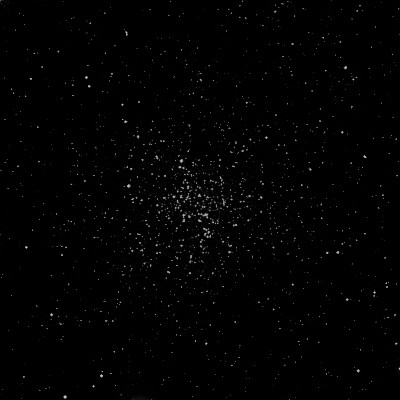
Nicolas-Louis de Lacaille discovered NGC 2477 = Lac I-3 = D 535 = h3103 in 1751-1752 using a 1/2-inch telescope at 8x during his expedition to the Cape of Good Hope. He recorded a "large nebula 15' to 20' diameter." James Dunlop described this cluster as "a pretty large faint nebula, easily resolvable into small stars, or rather a cluster of very small stars, with a small faint nebula near the north preceding side, which is rather difficult to resolve into exceedingly small stars. This is probably two clusters or nebula in the same line; the small nebula is probably three times the distance of the large nebula." Dunlop's position for D 535 is ~12' NW of center of the cluster.
John Herschel lists 3 observations in his Cape catalogue: on 1 Feb 1835 he recorded "Cluster 6th class, bright, large, rich, not very highly condensed in the middle. Stars very remarkably equal. All 12 or 13th mag. Very few 14th mag; none 11th mag. A fine object." On a second sweep he described it as "a very beautiful large cluster, very rich; stars nearly equal, and 12th mag, gbm, not much compressed in the middle; more than fills the field. (N.B. It is visible in the finder of the equatorial, and in the telescope of that instrument appears as a fine cluster." Finally on his last sweep he described it as a "Superb cluster, gbM, 20' diameter, much more than fills the whole field. Stars 10 and 11th mag all nearly equal."
200/250mm - 8" (3/28/81): beautiful, large cluster, very rich in faint stars mag 11-13 over unresolved haze. A mag 4 star is at the south edge.
300/350mm - 13.1" (2/18/04 - Costa Rica): remarkably rich carpet of mag 11-13 stars at 105x with perhaps 250-300 stars resolved in a 25' field. The appearance is very similar to a highly resolved globular without a sharply concentrated core. There are no distinct boundaries as stars loop outside the main group and many stars are arranged in long streamers. Located roughly 20' N of a mag 4.5 star (HD 64503 = b Puppis).
13.1" (12/22/84): superb cluster, over 200 stars resolved in a 25' diameter, very rich in mag 11-14 stars. Appears similar to NGC 7789 or a rich resolved globular cluster. Located just north of b Puppis (V = 4.5). This is one of the top open clusters in the sky despite the very low elevation!
600/800mm - 25" (4/6/19 - OzSky): at 244x; this amazing cluster filled the 25' field from edge to edge! The central 7' was extremely dense and still very rich all the way out. There are a couple of dozen 11th mag stars and over 500 stars from mag 12-15.5. It really looked superb - like an extremely large, loose concentration class, highly resolved globular cluster.
Notes by Steve Gottlieb
M 46
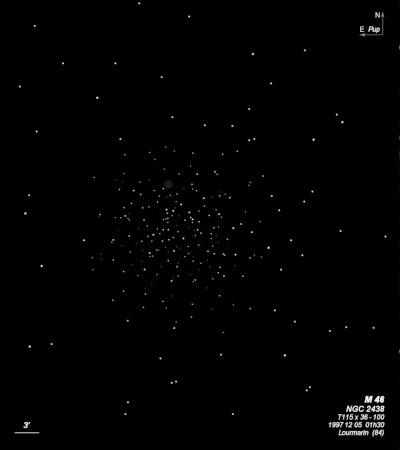
Charles Messier discovered M46 = NGC 2437 = h463 on 19 Feb 1771. Caroline Herschel found it again on 4 Mar 1783 and assumed it was new, realizing her mistake on 19 Nov. William Herschel described the cluster (unpublished) on 19 Mar 1786 as "a beautiful, very rich, compressed cluster of stars of various magnitudes." On 17 Dec 1827 (sweep 111), John Herschel logged, "the brightest part of a v fine rich cl; stars = 10m; which fills the field. Within the cluster at its n edge is a fine planetary nebula [NGC 2438]."
200/250mm - 8" bright, very rich, large, includes a couple of mag 9 stars but most stars are mag 10-13 and fairly uniform in magnitude and distribution except for a gap near the center. Contains the striking pn NGC 2438 at the NE edge. Faint naked-eye object in a dark sky.
400/500mm - 17.5" (3/16/96): At 100x, M46 fills a large portion of the field and there are a few hundred stars fairly evenly distributed in a 35' field. The cluster appears slightly elongated E-W although there are no clear borders. There is no increase in concentration towards the center and except for two brighter stars on the west side the cluster is unusually uniform in brightness (mag 11-13) and distribution in the main body. There is a noticeable 2' void, though, very close to the center of the cluster. Around the periphery the distribution becomes quite scraggly and the cluster mixes with the general field density. The beautiful annular planetary NGC 2438 is situated in the north side of the cluster.
Notes by Steve Gottlieb
NGC 2451
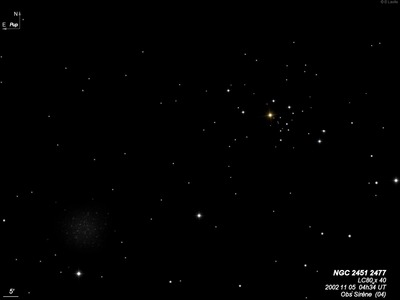
John Herschel discovered NGC 2451 = h3099 on 1 Feb 1835 and recorded "The chief star (4th mag) of an orange colour, of a very large and very diffused cluster of large stars, too loose to be a fit object for the ordinary magnifying power." His position matches mag 3.6 HD 63032. Giovanni Hodierna possibly made the original discovery around 1654 though it was not included in his catalog.
NGC 2451 consists of NGC 2451A and B, two young open clusters (50-80 million years) projected on each other along the same line of sight at distances of ~600 and 1200 light years, respectively.
200/250mm - 8" (3/28/81): very bright, very large, very scattered, includes mag 4 c Puppis. Resolved in 8x50 finder.
300/350mm - 13.1" (2/25/84): very bright scattered group of stars including yellow mag 3.6 c Puppis and about 10 bright stars. This naked-eye cluster appears very large but lacking in faint stars. Recent research shows this is a random grouping and not a cluster.
Notes by Steve Gottlieb
M 47
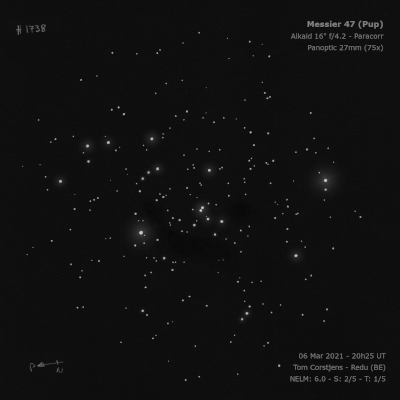
Caroline Herschel independently discovered M47 = NGC 2422 = H VIII-38 = h459 = h3088 on 26 Feb 1783. William Herschel found the cluster again on 4 Feb 1785 (sweep 366) and recorded "a very coarsely scattered cluster of several vL and other different sized stars." His summary description (including a second observation) reads "a cluster of pretty compressed large and small stars, round, above 15' diameter." From the Cape of Good Hope, John Herschel wrote, "a very large, pretty rich splendid cluster, which more than fills the field. Place of the chief star a find double star."
Giovanni Hodierna probably was the first to discover M47 before 1654 and simply recorded "a Nebulosa between the two dogs". Charles Messier rediscovered it 117 years later on 19 Feb 1771, though he clearly made an error as there is nothing at his position. Messier's missing object was assigned GC 1594 and NGC 2478. In 1959, Canadian amateur T.F. Morris identified M47 as identical to NGC 2422. See notes for NGC 2478.
200/250mm - 8" (11/5/83): very bright, large but scattered, includes STF 1121 = 8/8 at 7" near core and STF 1120 on west side, many colored stars.
300/350mm - 13.1" (11/5/83): very bright, very large, fairly rich, impressive. Includes double stars STF 1121 = 7.9/7.9 at 7" in the center and STF 1120 = 5.7/9.6 at 20" on the west side. Easy naked-eye object in a dark sky.
400/500mm - 18" (3/2/08): this naked-eye cluster was stunning at 73x (31 Nagler), though at 30' diameter it was too spread out for higher powers. The stars are arranged in beautiful chains and groups. The brightest half-dozen stars are in a 10' subgroup in the center including a striking white double star (STF 1121 = 7.0/7.3 at 7") that is is surrounded by many stars in chains and loops. The brightest star on the west side is a wide, unequal double (5.7/9.7 at 20"). Perhaps 200 stars are scattered around at low power.
Notes by Steve Gottlieb
M 93
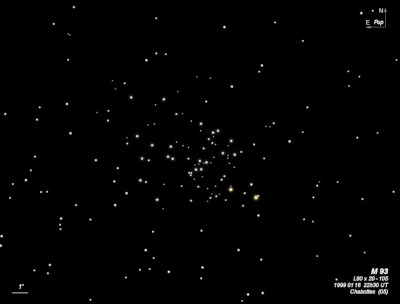
Charles Messier discovered M93 = NGC 2447 = h3098 on 20 Mar 1781. Caroline Herschel independently discovered the cluster on 26 Feb 1783 and recorded "Nebula, about 1 1/4 deg north preceding the bright star in the Ship [or more exactly] preceding the 1st Navis [Puppis] towards 23 Canis Majoris. My Brother examined it with [magnification] 460 and found not less than 20 stars, with 227 above 40. with a compound eyepiece perhaps 100 and 150 very beautiful, nothing nebulous among them. Messier has it not." Owen Gingerich determined that the reference to 1 (Rho) Navis, should read 7 (Zeta) Navis. Observing from the Cape of Good Hope, John Herschel noted "A fine cluster, scarcely scattered, pretty rich, not much more comp[ressed]. M [toward the middle]. Nearly fills field. Stars 8....13 m."
200/250mm - 8" (3/24/84): bright, very rich, triangular-shape, pretty compact, excellent field.
300/350mm - 13.1" (3/24/84): about 60 stars, bright, large, pretty rich. Contains a tight quadrilateral near the center with three faint companions.
400/500mm - 18" (3/2/08): very easy with any optical aid (at the threshold of naked-eye visibility) with a few of the brighter stars resolved in 15x50 IS binoculars. The cluster is fairly well resolved at 25x in the 80mm finder. The central region is superb in the 18" at 175x (13mm Ethos) with ~100 stars resolved in the 10' region and richest in the core. Appears fully resolved into mag 10-14 stars. A small, near parallelogram of 4 stars (sides ~40"x20") stands out near the center with numerous fainter stars nearby. The brightest star on the SW side of the cluster is a nice, unequal double (ARA 2066 = 8.3/11.3 at 10").
Notes by Steve Gottlieb
NGC 2439
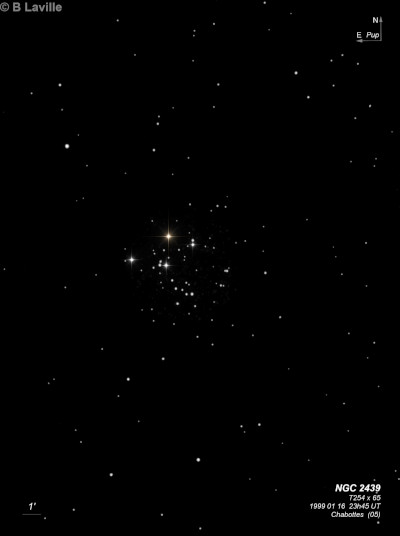
John Herschel discovered NGC 2439 = h3094 on 28 Jan 1835 and recorded "a cluster of about 150 stars, B, pL, p rich, not much more compressed to the middle, 8' diameter, has one star 8th mag (place taken), one red one 9th mag, the rest 12..14th mag."
400/500mm - 17.5" (1/19/91): at 220x, 70 stars visible in a 10' diameter. Bright, fairly large, elongated N-S. This is a rich, pleasing cluster and includes mag 6.7 R Puppis on the northeast edge. About 1' SW and 2' SSE of R Puppis are two easy but prominent double stars equally spaced with similar magnitudes but with perpendicular orientations (N-S and E-W). The pair 1.7' SSE is PRO 41 (9.2/10.3 at 12"). These wide double stars form a striking group and are part of an elliptical outline of stars with a void in center. Very unusual appearance!
Notes by Steve Gottlieb
NGC 2440
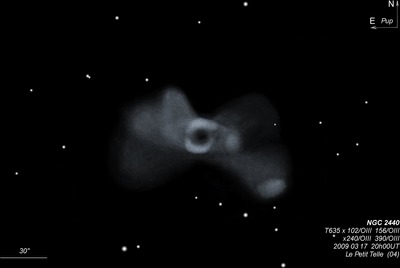
William Herschel discovered NGC 2440 = H IV-64 = h3095 on 4 Mar 1790 (sweep 934) and described a "beautiful planetary nebula of a considerable degree of brightness, but not very well defined. About 12 or 15" in diameter."
William Lassell observed NGC 2440 in Jan 1853 with his 24-inch equatorial reflector on Malta. He commented, "no description can do justice to this singular object. With 150 it just attracts the eye in sweeping, as a a bluish-white spot, a few seconds in diameter. A most extraordinary object [at 650x], not beautiful, for it has no symmetry – but wonderful." His sketch, showing 4 or 5 knots, was included in his 1854 MRAS paper (figure 7). Father Angelo Secchi published a detailed sketch and description in 1856 using the 9.6" refractor in Rome. He noted, "It seems to consist of two twin nebulae joined to a third transverse elliptical nebula…but it is very difficult to recognize the true structure."
Ralph Copeland made a careful observation at Birr Castle on 20 Jan 1874: "vB, pL, very blue. An eB nucleus which is E or bi-central in pos 151.4° in vF outer nebulosity, vmE 33.1° and 2' or 3' long. 35 stars in field (diam 11'), the nearest of which is *16m pos 200.8°, dist 54.8"..." A sketch was prepared by Joseph Turner (unpublished plate V, figure 43) with the 48" Melbourne Telescope and Pietro Baracchi made a careful observation on 17 Mar 1885.
Based on Crossley photographs, Heber Curtis (1918) reported NGC 2440 has "no central star; the strong central masses are nebulous in the shortest exposures. A very irregular and patchy oval; main portion 54"x20" in pa 37°, with a faint extension at east, north of the middle."
300/350mm - 13" (2/23/85): very bright and small with a very high surface brightness. This planetary has a double shell structure with an elongated box-shape oriented NW-SE and a fainter shell oriented SW-NE. One or two condensations are visible in the central part. Located 3.0' W of mag 8.4 orange HD 62167.
400/500mm - 17.5" (2/14/99): this bi-polar planetary reveals fascinating detail at 380x! The compact high surface brightness inner region is elongated NNW-SSE. Two bright knots comprise both ends and the surface brightness is irregular. The nebulosity is much weaker SW of the main body with a cup-shaped dark "notch" protruding into this central bar. The outer halo is oriented SW-NE with a brighter wing similar to a spiral arm attached at the west edge which swings back towards the south. The outer nebulosity is weaker and less well-defined on the north and NE sides.
900/1200mm - 48" (2/20/12): the view of this explosive appearing planetary was remarkably detailed at 488x and 814x. The very high surface brightness central region was irregularly shaped with a very ragged periphery, giving the impression that the central region was erupting or bursting. Within the east side of the central portion are two intense condensations or knots, oriented ~N-S, with the southern knot brighter. A third, smaller elongated knot is just west and sits close to the center. The main body is elongated nearly 2:1 SW-NE, roughly 1.1'x0.6', but with an irregular outline. The southwest end of the planetary dims and protrudes out, creating a cup-shaped hollow with a very small brighter knot at its southwest tip. A prominent partial loop or outer wing is attached on the northwest edge of the central section, like a spiral arm, and swings clockwise to the west and slightly south. The eastern portion of the planetary consists of a large complete, irregular loop (darker in the interior), giving the strong appearance of being blown out from the central region.
Notes by Steve Gottlieb
NGC 2539
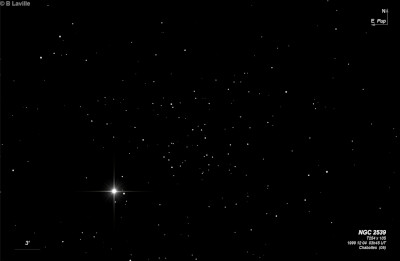
William Herschel discovered NGC 2539 = H VII-11 = h3114 on 31 Jan 1785 (sweep 363) and called it "a cluster of stars, coarsely scattered, but considerably rich, above 20' diam." JH, observing from the Cape of Good Hope, recorded "a large, extended, rich cluster. Fills field; stars 12th mag approx. A bright star (6th mag) S.f."
300/350mm - 13.1" (2/25/84): about 85 stars in a 20' diameter. Fairly rich with uniform magnitudes. A brighter mag 10/11 pair at 21" is on the north side. Located about 10' NW of 19 Puppis (V = 4.7).
400/500mm - 18" (3/2/08): this cluster is situated 10' NW of 4.7-magnitude 19 Pup. Roughly 125 stars are spread out over a 20' region. At the NW end is a roughly equal mag pair, an 11" pair is on the east side and a brighter mag 10/11 pair at 20" is on the NE side.
Notes by Steve Gottlieb
NGC 2482
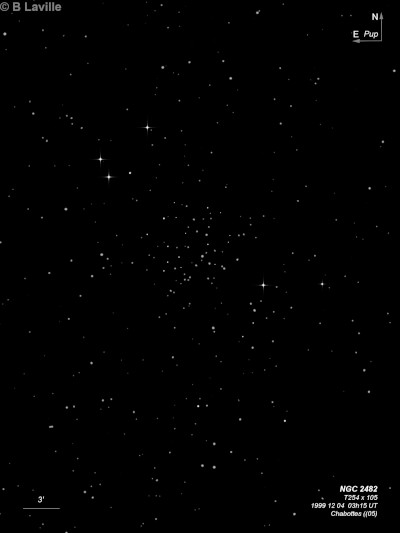
William Herschel discovered NGC 2482 = H VII-10 = h474 = h3106 on 20 Nov 1784 (sweep 326) and recorded "a cluster of scattered stars, the stars nearly of a size, more than 15' diam, but not compressed." On 6 Mar 1785 (sweep 381) he noted "a L cluster of scattered stars, considerably rich and compressed; my field is too small to determine the extent of it." Observing from the Cape of Good Hope, John Herschel reported "a very rich milky way cluster, or mass of stars, 10, 11 and 12th mag, diameter 20'. The neighbourhood is rich, but much less so than this cluster." His position is a couple of arcmin south of center.
300/350mm - 13.1" (12/7/85): about 50 stars mag 10-14 in cluster. The bright stars from a "Y" asterism. Located 1.5° ENE of Xi Puppis.
400/500mm - 18" (3/2/08): distinctive group of 80-100 stars at 175x in a 10'-12' field. A long, rich string of stars oriented NW-SE passes through the middle of the cluster with arms or sprays of stars extending outwards from this string. The stars are fairly evenly distributed and similar in magnitude with several close doubles. A mag 8 star (HD 64820) is off the west side of the cluster.
Notes by Steve Gottlieb
NGC 2546
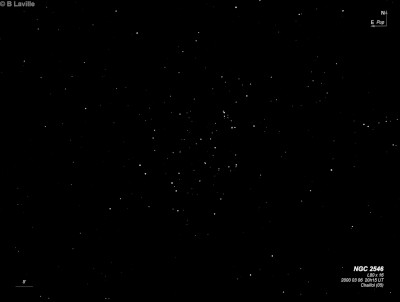
Nicolas-Louis de Lacaille discovered NGC 2546 = Lac II-4 = D 563 = h3116 in 1751-1752 using a 1/2-inch refractor at 8x during his expedition to the Cape of Good Hope. He recorded II-4 as follows: "One sees with the naked eye two neighboring confused groups of stars; but with the telescope they are faint, distinct stars, very numerous & very close together."
James Dunlop observed the cluster on 8 May 1826 and recorded "a large cluster of stars of mixt magnitude, rather extended figure, not rich in very small stars." He made two observations and his position is 17' N of center (typical error). JH made 3 observations from the CGH, first recording on 1 Feb 1835 "a cluster 8th class of about 20 bright stars in an oblong, 8' long, 3' broad."
200/250mm - 8" (3/28/81): ~25 stars, rich, elongated. At the edge of a large, scattered field of stars.
300/350mm - 13.1" (1/30/06 - Costa Rica): this very large, bright scattered cluster was just visible to the naked eye close south of a brighter, hazy naked-eye patch of unresolved stars. The field is beautifully rich, at least 45' diameter though there was no distinct border. The star field looks impressive beyond the edges of the 66' field of the 20 Nagler. On the northwest side is a rich, elongated strip of ~20 stars that is quite eye-catching. Includes a few pairs and a neat triple with a fairly close unequal mag pair at the SSW end of the elongated strip.
13.1" (2/18/04 - Costa Rica): this cluster is a very bright, scattered field of stars that completely fills the nearly 40' field at 105x. Partially resolved in the 9x50 finder. At the NW edge is a rich elongated strip of two dozen stars including a couple of close, unequal pairs and tight fainter triple. John Herschel's description applies to this denser group of stars. A mag 6.4 star (h4051 = HD 68450) with two mag 13.5 companions is off the NW side of the larger group but does not appear to be part of the cluster and a similar star lies to the SE (HD 68862).
13.1" (1/18/85): ~75 stars, bright, very large, scattered, overfills 30' field.
Notes by Steve Gottlieb
NGC 2527
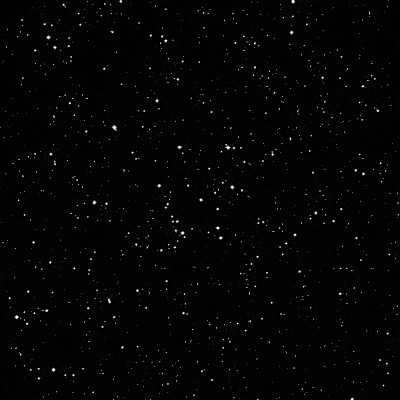
William Herschel discovered NGC 2527 = H VIII-30 = h488 on 9 Dec 1784 (sweep 333) and noted "a very large cluster of many coarsely scattered large stars." From Sloughon 7 Jan 1831 (sweep 317), John Herschel wrote "p rich; v coarsely scattered; fills field; st 10...15m. RA by working list [marked as uncertain]. He also observed the cluster while in South Africa but his RA was 3 minutes too far west. As a result it inherited two NGC numbers, so NGC 2527 = NGC 2520.
400/500mm - 17.5" (3/7/92): 75-100 stars mag 10-14 in very large 30' loose group. This cluster is fairly bright with two fairly rich subgroups. The central 10' core includes about two dozen stars with a mag 10 star at the NW corner which has three fainter companions within 35". A rich string of faint stars oriented SSW-NNE of length 4' has two mag 10-11 stars at the endpoints. Outliers extend east and west and include a rich elongated group at the NE edge of the cluster.
Notes by Steve Gottlieb
NGC 2423
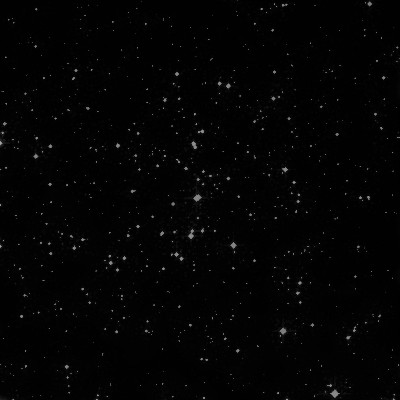
25x80mm finder (3/2/08): A chain of stars extends north from M47 to this obvious glow with a few resolved stars superimposed.
15x50 IS binoculars (1/15/07): visible about 40' N of M47 in binoculars as a faint glow with the brighter mag 9 and 10 stars resolved.
William Herschel discovered NGC 2423 = H VII-28 = h3090 on 19 Mar 1786 (sweep 540) and noted "a cluster of pS stars, pretty rich, 15' diameter." His position is accurate. JH observed the cluster from the Cape of Good Hope and recorded "a very large, rich fine cluster of small stars which nearly fills the field. Place that of a double star, class II."
300/350mm - 13.1" (1/28/84): about 50 stars in 15' field. Fairly rich in faint stars. A mag 9 double star is near the center. The primary, itself, is a very close pair (RST 3532 = 9.6/10.2 at 0.5"). Located 37' N of M47.
400/500mm - 18" (3/2/08): at 175x, ~100 stars are resolved in a 18' region with an excellent double at the center (h3983 = 9.1/9.7 at 8"). The stars are pretty evenly distributed with no rich subgroups though with several doubles and small groupings.
Notes by Steve Gottlieb
NGC 2579
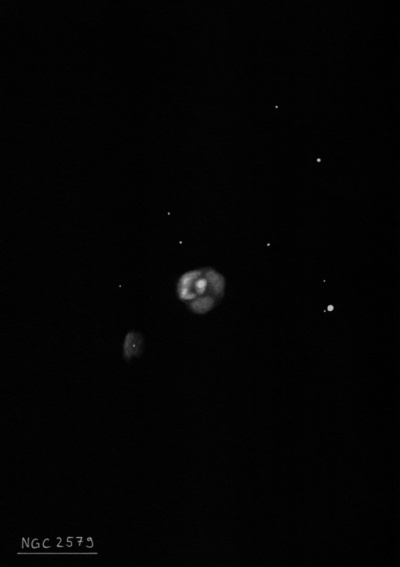
John Herschel discovered NGC 2579 = h3122 on 1 Feb 1835 and recorded "A double star (h4083) involved in pB nebulosity, which seems to belong to both stars; but of the two the smaller is more nebulous; diameter 50"; in a pretty rich patch of the milky way." The next night he logged "a double star, or a star and a nebula, very close and involving the star ... the field contains about 70 stars, of which 8 are about 9th mag. I cannot be quite positive that the neb extends beyond the large star, or that the small one is not a mere condensation of it. However, I remain pretty well satisfied of its investing both." His mean position (4 sweeps) corresponds with this compact HII region.
Joseph Turner described NGC 2579 as two pairs of double stars on 14 Feb 1882 with the 48" Melbourne telescope. Both pairs are oriented ~N-S on his sketch with the brightest star at the west end.
The Lynga catalogue includes NGC 2579 as an open cluster at 08 20.3 -36 15 (1950), placing the object 20' too far SE! At the Lynga position is a scattered group of stars. This error is repeated in amateur sky-plotting software such as MegaStar. ESO 370-PN?009 is a faint, detached piece off the southeast side with a separate ionizing star.
400/500mm - 17.5" (2/1/92): small, bright compact nebula involving a mag 10.5 star. Visible without filter as a small bright knot forming a close double with the mag 10.5 star just west. Using an OIII filter at 140x the size increases to 2' diameter and encompasses the mag 10.5 star. With this combination the nebula is quite prominent as the surface brightness is quite high! Located within a large scattered group of about 20 stars.
Notes by Steve Gottlieb
NGC 2421
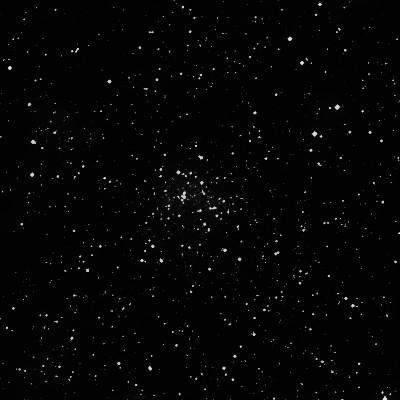
William Herschel discovered NGC 2421 = H VII-67 = h3089 on 30 Jan 1799 (sweep 1089) and described "a cluster of compressed stars, considerably rich." JH recorded it from the Cape of Good Hope as "a large fine rich cluster, not much compressed, but nearly filling the field. Stars 11..13th mag, no conspicuous star, place that of a coarse double stars 11th mag."
200/250mm - 8" (1/1/84): almost three dozen faint stars, triangular-shape, rich field.
400/500mm - 17.5" (3/7/92): about 60 mag 10-14 stars in a 10' field. Many stars are similar magnitudes and the cluster is pretty evenly distributed. Brighter stars at the borders give a triangular outline including mag 10.5 stars at the SW, SE and NE edges. A wide brighter double star (ARA 962 = 10.9/11.5 at 18") oriented N-S lies NE of center and two faint companions are also near.
Notes by Steve Gottlieb
NGC 2298
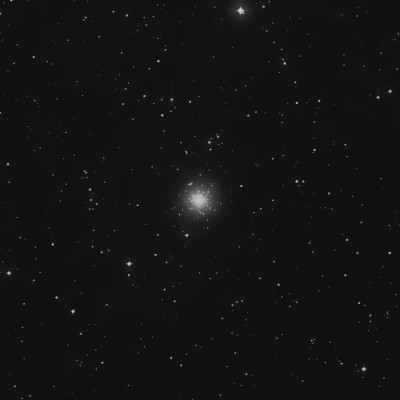
James Dunlop discovered NGC 2298 = D 578 on 8 May 1826 and described "a pretty bright round nebula, 3' or 4' diameter, moderately condensed to the centre. This is resolvable into stars." He made 6 observations and his published position is 6' W of center of the globular.
JH observed the globular (h3065) on four sweeps from the Cape of Good Hope, first recording it on 2 Feb 1835 as "B, R, gpmbM, 3', all resolved into stars 14th mag. In the centre is a star 13th mag."
200/250mm - 8" (1/1/84): no resolution, fairly small, smooth.
300/350mm - 13.1" (2/20/04 - Costa Rica): at 200x, this is a compact, fairly bright globular that is well-concentrated with a bright 1.5' core and a fainter halo of ~3' diameter. Roughly two dozen stars are resolved (brightest cluster members are mag 13.4) including several across the core and a number of stragglers, which are easier to resolve in the outer halo.
400/500mm - 17.5" (1/31/87): moderately large globular with no sharp core. A dozen stars are resolved over the mottled disc.
600/800mm - 25" (4/6/19 - OzSky): at 244x; extremely bright, large, highly resolved globular with an intensely bright 1.5' core and a scraggly 4' halo. Due to a fairly loose structure and brighter members, the cluster was well resolved into more than 50 stars. A number of fairly bright stars are plastered across the core and the halo contains a few dozen brighter stragglers. A noticeable chain of stars begins in the core and extends southwest. A brighter star (double) is near the edge of the halo on the NE side.
Notes by Steve Gottlieb
NGC 2509
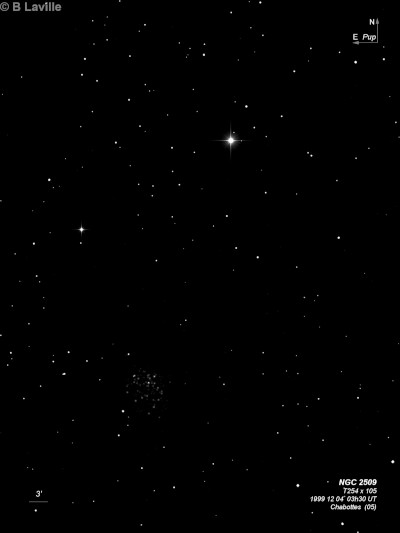
William Herschel discovered NGC 2509 = H VIII-1 on 3 Dec 1783 (very early sweep, internal discovery #7) and recorded "a cl of coarsely scattered stars. The place is that of the most comp part, which is not M[iddle]" On 4 Mar 1790 (sweep 934) and logged "a considerably compressed and very rich cl of small star, irr F." and on 15 Mar 1801 (sweep 1095) he noted "a beautiful cl of stars, arranced in a circular order."
400/500mm - 17.5" (3/12/94): 50 stars resolved in a 6'x5' region outlined by a perfect parallelogram. The majority of the stars, though, lie in a prominent dense clump along the NW side of the parallelogram and includes a nice double star. The NE vertex of the parallelogram is a double star with components mag 13/13.5 at 12". The parallelogram has no concentration and the interior southern portion has only a couple of faint stars. Mag 8.6 SAO 153720 lies roughly 6' SE and a bright wide double star consisting of a mag 10.5/12 pair at 26" is 4' NNE of the parallelogram.
Notes by Steve Gottlieb
NGC 2438
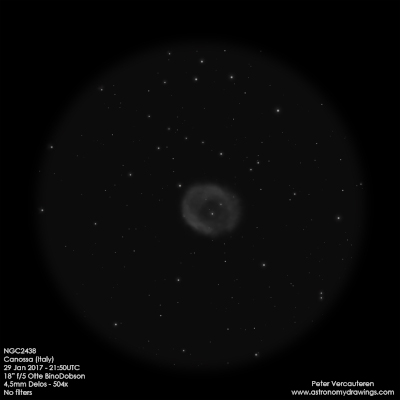
80mm (1/15/07): visible continuously in the finder using an OIII filter and a 13mm Nagler (25x) as a very faint, very small disc on the NE side of M46.
William Herschel discovered NGC 2438 = H IV-39 = h464 = h3093 on 19 Mar 1786 (sweep 540) and recorded "pB, R, resolvable, within the 46th of [Messier], almost of an equal light throughout, about 2' diameter, no connection with the cluster, which is everywhere free from nebulosity." On 8 Mar 1793 (sweep 1034) he noted "A round, pretty well defined nebula; almost of a planetary nebula aspect." From South Africa, John Herschel wrote, "a very fine planetary nebula, oval, uniform in light, and of a very flat appearance; rather faint; diam in RA = 4 seconds; has a star 15th mag on it, and one 13th mag close to its border. This object is excentrically situated in a superb cluster of stars 12..16th mag. (46 Messier)"
Lord Rosse or assistant Johnstone Stoney sketched NGC 2438 as annular on 22 Dec 1848 (figure 12 in the 1850 PT paper). It was observed a total of 21 times at Birr Castle including with a visual spectroscope on 15 Feb 1876. William Lassell also noted the annularity using his 24" equatorial reflector on 11 Jan 1853: "The star is not in the centre, and the nebula seems to retreat from the star, leaving it on a much darker ground than the external parts of the nebula. With slight attention another star is seen; and two or three points or bright spots in the nebula occasionally catch the eye." His sketch was published in his 1854 MRAS paper (figure 5) on observations from Malta. Perhaps following Lassell's lead, Secchi sketched in 1856 the "central star" slightly eccentric, along with a second interior star using the 9.5" refractor in Rome.
Based on Crossley photographs, Curtis (1918) reported "the nebula is a very irregular, broad, patchy ring 68" in diameter. The star at SW lies in a gap in the ring."
This planetary is not physically associated with M46 based on differing radial velocities and the youthful age of cluster and is probably superimposed in foreground). Les Dalrymple states a distance of 4500 l.y. for the cluster and only 3000 l.y for the planetary in a S&T article (Dec 2002).
200/250mm - 8" (1/1/84): slightly darker center, fairly small, round.
300/350mm - 13.1" (1/18/85): star near center very easy and second interior star definite.
13.1" (1/28/84): annular planetary on the NE side of M46! Fairly bright, moderately large, round, 1.0' diameter. A mag 11 star is just off the SE edge and a mag 13 star is just NW of the geometric center (this is not the central star). A third extremely faint star lies on the SW side.
13.1" (11/5/83): clearly annular at 166x.
400/500mm - 17.5" (3/2/02): at 280x this is a beautiful, 1' diameter PN with a darker central hole at 280x situated on the NE side of the rich oc M46. A mag 13 star (not the central star) is within the central hole slightly offset NW of center. The rim is fairly uniform but slightly brighter along the NE side. The 20" central hole is clearly darker although there is not a dramatic contrast. A brighter mag 11 star is just off the SE edge (about 15"-20" SW of the mag 11 star, a faint mag 14-15 star was also intermittently visible) and a string of faint stars oriented WNW-ESE is just over 1' S. M 1-18 is located 22' NNE of NGC 2438.
900/1200mm - 48" (2/20/12): at 488x, much of the same detail described in the 4/15/10 observation was seen, although the ring itself was less structured. Besides the slightly off-center bright star (the ionizing star is a mag 17.5-18 companion) and a mag 14.5 star ~15" SW, a 16th mag star is at the edge of the rim on the SW side. A mag 16 star on the SE side appears just inside the bright ring. Finally another 16th mag star is near the north edge of the annulus, but clearly within the planetary, for a total of 5 interior stars. The outer rim brightens at this point in a 90° arc to the east and is slightly flattened. The challenging Calabash Nebula (protoplanetary) lies 6.5' ENE.
48" (4/15/10): at 700x, NGC 2438 was a beautiful "cheerio" ring with a sharply defined rim of 1.2' diameter and a fairly large, dark central hole of 25-30". The mag 12.8 star in the center was prominent with a second mag 14.5 star ~15" SW of center. A third mag 16 star was just inside the annulus on the SE side, ~20" from center. The rim had a very uneven surface brightness with an impression of some radial streaks and one or two additional faint, embedded stars. The rim was noticeably brighter along the NE quadrant and to a slightly lesser extent along the opposite SW portion of the rim, creating a bipolar appearance. A bright mag 11 star is just off the SE side and the planetary floats in the beautifully rich star field of M46.
Notes by Steve Gottlieb
NGC 2452
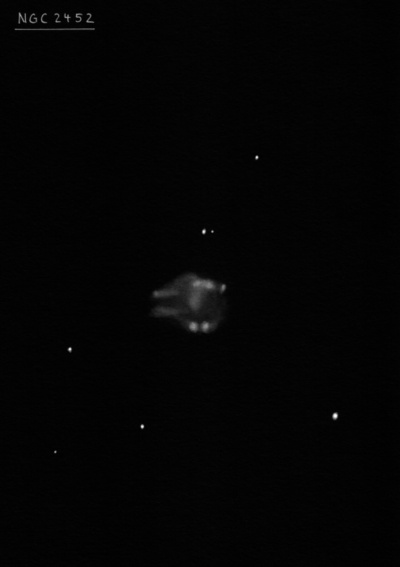
John Herschel discovered NGC 2452 = h3100 on 1 Feb 1837 and described as "An object whose nature I cannot make out. It is certainly not a star, nor a close double star; but it is not round, and I should call it an oblong planetary nebula, by reason of its decidedly marked though somewhat dim outline, were there not some suspicion of its being double, as if a very close and highly condensed double nebula. It is very small and rather faint, 8" long, 5" broad, and equals a star of 10th mag. In a field with at least 60 or 80 stars [NGC 2453], all sharp and well defined but this. Four nights later he recorded "Planetary nebula. In a field with, and south of a cluster, and on a rich ground is the undefined object of Sweep 769. It is no doubt a very faint, small, round planetary nebula..."
A lithograph was prepared based on a sketch by Joseph Turner using the Great Melbourne Telescope (plate V, figure 44) but his drawing was never published.
Based on a Crossley photograph at Lick Observatory, Curtis (1918) reported "there is probably a faint central star, not brighter than mag 19. Extreme length about 22" in pa 85° the centers of the bright lateral lobes are 11" apart. In this exposure time the object has much the appearance of a reversed letter Z." Based on radial velocity, NGC 2452 is in the foreground of open cluster[NGC 2453.
300/350mm - 13" (3/24/84): moderately bright, small, slightly elongated N-S, no interior star visible. Located 6' S of open cluster NGC 2453.
400/500mm - 17.5" (3/2/02): at 380x this is a moderately bright, fairly small but interesting planetary. Appears elongated N-S, ~30"x20" with an irregular surface brightness and a slightly darker center or a darker spot. The halo appears brighter at the north and south ends giving a slightly bipolar appearance with the impression of two lobes diminishing in brightness in the center. A faint mag 14.5 star is just off the north edge. Located 8' S of open cluster NGC 2453.
Notes by Steve Gottlieb
NGC 2571
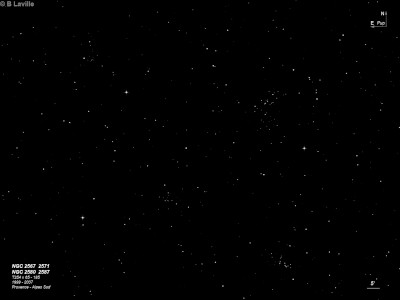
William Herschel discovered NGC 2571 = H VI-39 = h502 on 3 Mar 1793 (sweep 1032) and noted "a cluster of large stars, considerably rich, iR, above 15' diameter." John Herschel logged it on 6 Jan 1831 (sweep 316) as "a v loose straggling but p rich cl which fills the field, st 9m and under; vl comp middle. Some large st preced it."
300/350mm - 13.1" (3/24/84): 18 stars mag 8.8-12 in 10' diameter. Includes a wide bright pair (mag 8.8 SAO 175580 and 8.9 SAO 175577) at 1' separation oriented NW-SE near the center. This cluster is larger and contains brighter stars than NGC 2587 one degree ENE. Also NGC 2580 lies 47' SE and NGC 2567 54' S.
600/800mm - 24" (3/21/20): at 200x; very interesting cluster with ~30 stars in the core of the cluster, including two 9th mag stars, HD 70058 and 70078, oriented NW-SE and a large number of stars 10th-11th magnitude. The "core" stars are pretty isolated by a wide, mostly empty ring with only much fainter stars. At a radius of 4' from the center is a prominent string of stars to the NW (oriented SW-NE) and an extensive group of stars to the south that may also be part of the cluster. Including the large group out to 13' diameter increases the total to 100-120 stars (though a large number are unrelated stars), but it appears too loose to be distinctive at this size. This region of the Milky Way is rich in bright and faint stars: a 7th mag star (HD 69817) is 17' WNW and mag 6-7th mag stars are 20' SW and 20' NE.
Notes by Steve Gottlieb
NGC 2409
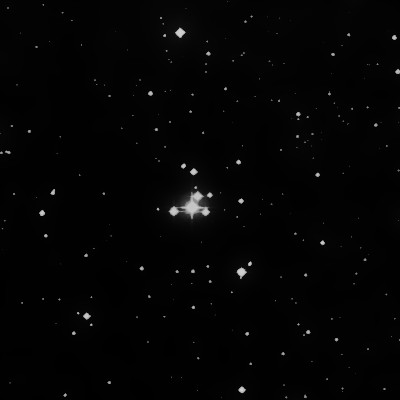
John Herschel discovered NGC 2409 = h3086 on 12 Feb 1836 and noted "a small but brillliant group of 6 or 8 large stars, 8, 9, 10m, within a very small compass." His position matches this small, bright group of stars. While observing with the 72", Dreyer called this group "only 4 stars 9...11 mag and some fainter ones. I suppose there are millions of such clusters." Herbert Howe noted it "Consists of 10 scattered stars." This knot of stars is plotted on Norton's Star Atlas but RNGC classifies the number as nonexistent (Type 7).
400/500mm - 17.5" (2/9/02): small, bright, distinctive group of 8 stars mag 9-11.5 in a 2' knot. Includes two mag 9 stars in a small quadrilateral and two other pairs. Stands out well in the field, though seems too sparse to be a real cluster (Bochum 4).
Notes by Steve Gottlieb
NGC 2396
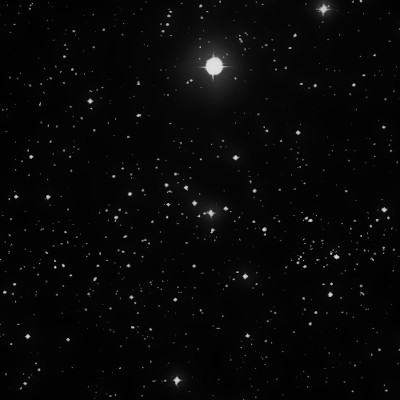
William Herschel discovered NGC 2396 = H VIII-36 = h451 on 31 Jan 1785 (sweep 363) and called it "a coarsely scattered forming cluster about 20 or 30' diam." His position is within this scattered group. John Herschel simply called this object a "straggling portion of the Milky Way."
400/500mm - 17.5" (2/8/91): about three dozen stars mostly mag 11-13 are resolved at 82x. Evenly distributed, not rich and does not stand out well in a rich field. The brightest star is mag 8.7 SAO 152910 situated at the west side. Located 10' S of ∑1097 = 6.1/8.5 at 20"!
Notes by Steve Gottlieb
NGC 2567
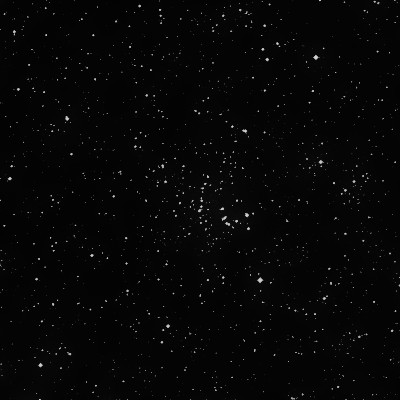
William Herschel discovered NGC 2567 = H VII-64 = h503 = h3120 on 4 Mar 1793 (sweep 1033) and recorded "a large cluster of stars of a middling size, irregularly extended and considerably rich. The stars are chiefly in rows." In his 1814 publication, Herschel speculated that each row of stars may have a different preponderating attraction, but every row will attract all the other rows..." John Herschel logged it on 6 Jan 1831 (sweep 316) as "a fine, p rich cl; stars 11m pretty uniform 5..6' diam. The chief stars make a zigzag line, the outliers extending 20'."
300/350mm - 13.1" (3/24/84): about two dozen stars mostly mag 11-13 in 10' diameter elongated N-S. Includes a long string oriented N-S on the east side. On the SW wide is a "U" shaped group of brighter stars open to the north. Mag 9.0 SAO 199057 lies 6' SW. First in a group of four open clusters with NGC 2571 54' N, NGC 2580 44' NE and NGC 2587 93' NE.
Notes by Steve Gottlieb
NGC 2483
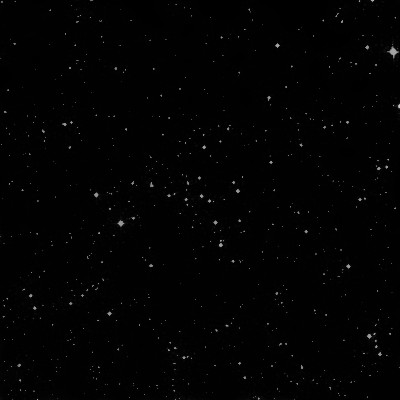
25x80mm (3/2/08): easily visible as a hazy cloud with several faint stars superimposed.
John Herschel discovered NGC 2483 = h3105 on 22 Jan 1835 and recorded "Cluster 8th class. Large; loose and straggling. A milky way cluster." His position is about 1 min of RA west of this cluster.
400/500mm - 17.5" (3/7/92): scattered group of 30 stars mag 9-14 in 10' diameter. Contains mag 8.9 SAO 174829 and a mag 10 star at the east end with 2.5' separation NW-SE. Most of the member stars are arranged in two well-defined intersecting lanes oriented SW-NE and NW-SE. There are no dense areas or prominent double stars.
Notes by Steve Gottlieb
NGC 2533
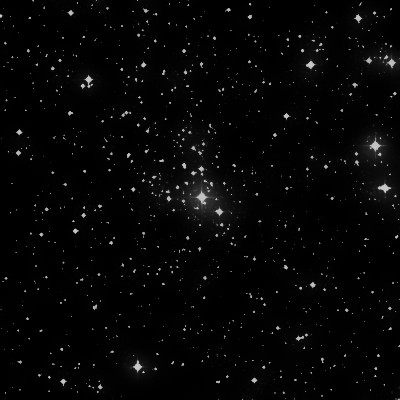
John Herschel discovered NGC 2533 = h3113 on 22 Jan 1835 and recorded "place (RA doubtful) of a *9 m; cheif of cl p rich; irreg R; glbM; 5'; stars 13m. Belong to milky way, but is a much more compressed part of it."
400/500mm - 17.5" (2/8/91): about 20 stars surrounding mag 8.8 SAO 175203. Also includes a mag 10.5 star but the remainder are 13th and 14th magnitude. Fairly small, 4' diameter, does not stand out well in rich field.
Notes by Steve Gottlieb
NGC 2414
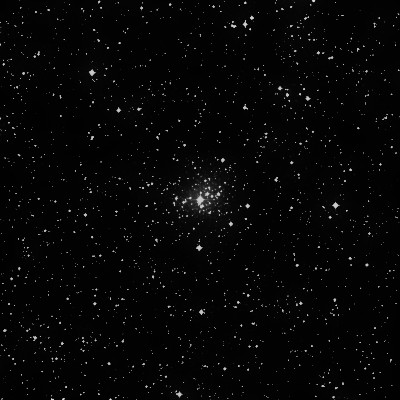
William Herschel discovered NGC 2414 = H VIII-37 = h455 on 4 Feb 1785 (sweep 366) and recorded "A small cluster of scattered stars of various sizes, not very rich." John Herschel noted on 16 Dec 1827 (sweep 111) "a cl with 1 st 9m; not rich." and measured an accurate position.
300/350mm - 13.1" (1/11/86): about 20 faint stars surrounding mag 8.2 SAO 153056 with some unresolved background haze. The cluster members are arranged in two curving lanes with a mag 8.2 star at the center, elongated ~E-W. Pretty view at high power.
400/500mm - 18" (3/2/08): very pretty cluster with ~40 stars mag 12-14 resolved in a 4'x3' group using the 13mm Ethos (175x). A mag 8.2 star (HD 60308) is superimposed at the center and sprays of stars to the NW, north and east appear to radiate outward from the bright star. A half a dozen brighter mag 10-10.5 stars form an 8' incomplete ring that partially encompasses the cluster (open to the east).
Notes by Steve Gottlieb
NGC 2489
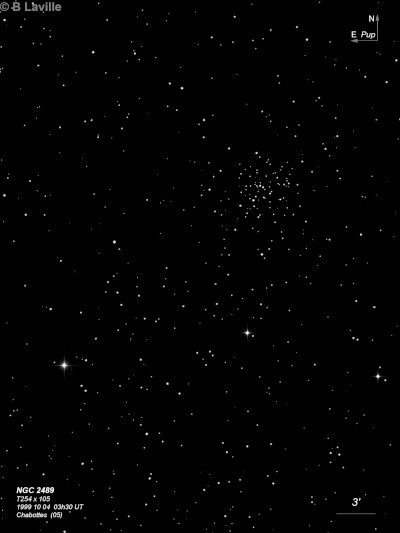
William Herschel discovered NGC 2489 = H VII-23 = h479 = h3107 on 30 Dec 1785 (sweep 501) and reported "a compressed cluster of pretty large stars, considerably rich." This cluster was probably first discovered by James Dunlop on 28 May 1826 and logged as "a cluster of small stars, of an irregular round figure, with faint nebula, easily resolvable. The 257 Argus is south following." His position for D 626 is 30' WNW of center, but despite the poor position the description is reasonable.
JH observed the cluster from the Cape of Good Hope on 22 Jan 1835 and recorded "A round, pretty compressed cluster of stars 11..13th mag; 6th or 7th class; gradually brighter in the middle, pretty rich, 7' diameter." On a second sweep he wrote "Cluster 7th class. Round, 5' diameter, stars 12th mag."
300/350mm - 13.1" (1/18/85): about 50 stars in a 8' diameter. Rich in mag 11-14 stars. A richer group of stars is at the center surrounded by a larger incomplete ring of stars. Located 13' N of mag 6.3 PX Puppis (6.3-6.7).
Notes by Steve Gottlieb
NGC 2453
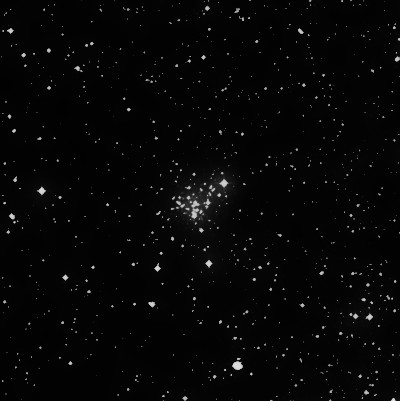
John Herschel discovered NGC 2453 = h3101 on 5 Feb 1837 and recorded "a small but condensed cluster, Class VII. Pretty rich. Dia 3'. [This is the cluster referred to, as in the field with the Planetary Nebula (NGC 2452).]"
300/350mm - 13.1" (3/24/84): about a dozen stars resolved in a compact 2.5' cluster including three mag 9.5-10 stars. The brightest mag 9.5 star is at the NW edge. There is one dense, partially resolved clump. Planetary nebula NGC 2452 lies 6' SSW. Clouds may have interfered with the observation.
400/500mm - 17.5" (3/2/02): at 220x, this is a small but dense open cluster with about two dozen stars resolved in a 3' region with a mag 9.5 star (HD 63360) at the NW edge. A very rich 1' clump of mag 12-13 stars is on the SE side with a mag 11.5 star at the south tip of this clump. Two mag 10 stars are 3' S and 3' SE of the central group. Planetary nebula NGC 2452 is in the field 8' SSW making for an interesting pair.
Notes by Steve Gottlieb
NGC 2587
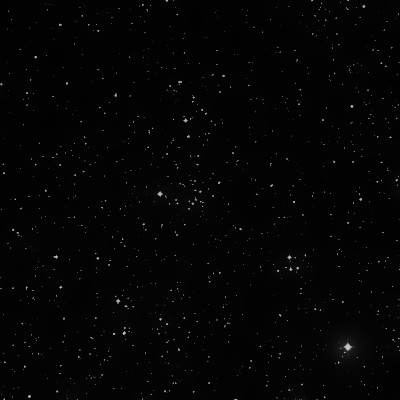
John Herschel discovered NGC 2587 = h3124 on 22 Jan 1835 and described "a milky way cluster 7th class; irreg fig; pretty much compressed in middle. Stars 10...13m; one 9 m."
300/350mm - 13.1" (3/24/84): 15 faint stars over haze in a 5' diameter extended N-S with mag 9 SAO 17537 at the SE edge. A mag 11.5 star is at the north edge but most members are mag 12-13.
Notes by Steve Gottlieb
NGC 2479
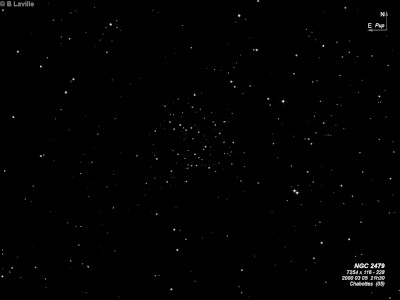
William Herschel discovered NGC 2479 = H VII-58 on 4 Mar 1790 (sweep 934) and reported "a pretty compressed and rich cluster of small stars, iR, about 7 or 8' diameter." His position is on the southwest side oft his cluster.
300/350mm - 13.1" (12/7/85): about 50 faint stars spread out in a 10' diameter over some haze. Several stars near the center are arranged in a semi-circle open on the east side. A string of stars trail off to the SE.
400/500mm - 18" (3/2/08): at 175x, over 80 stars mag 12-14 are resolved in a 9' region with the cluster extended WSW-ENE. A semi-circular loop of stars is near the center and is open on the east side. The cluster is ~10' NE of a fairly well matched, bright wide pair (h4015 = 9.1/9.5 at 20").
25x80mm (3/2/08): in the finder this cluster appears as a hazy 8' cloud with no resolution
Notes by Steve Gottlieb
NGC 2580
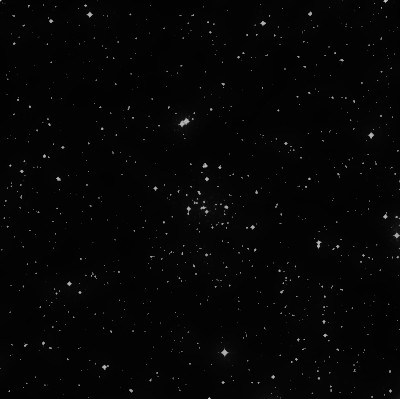
John Herschel discovered NGC 2580 = h3123 on 5 Feb 1837 and described a "cluster 7th class; R; p rich; insulated; 10' diam; stars 12m, nearly uniform." His position is ~1.0' SE of center of this cluster.
300/350mm - 13.1" (3/24/84): 15-20 stars mag 10-13 within a rectangle of stars. A brighter double star is close north. Located 44' NE of NGC 2567 and 47' SE of NGC 2571 in a group of 4 open clusters along with NGC 2587 53' NNE.
Notes by Steve Gottlieb
NGC 2568
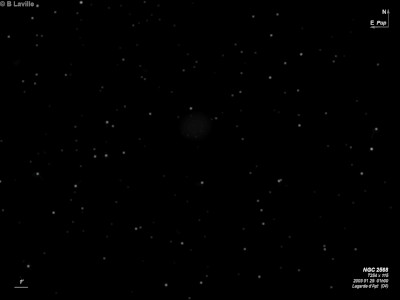
E.E. Barnard discovered NGC 2568 in 1881 with his 5-inch refractor in Nashville while sweeping for comets. In Sidereal Messenger, Vol 3, p60, he described a "very faint nebulosity of moderate extension; pretty even in light. A small star involved." In The Observatory, 8, p123, he wrote "Faint, close to, and south preceding a small star; the star is partly involved in the nebula." The latter observation was probably made with the 6-inch Cook refractor. So, with the 5- and 6-inch scope he didn't resolve the cluster. His discovery list in AN 2588 (1884) mentions Oliver Wendell, using the 15-inch refractor at Harvard College Observatory, described it as "rather diffuse and faint, but gradually a little brighter in the middle." I'm surprised the large refractor didn't provide some resolution. Paris Pismis reported the cluster as new (= Pismis 1) in her 1959 list of clusters found on Schmidt plates at the Tonantzintla Observatory.
Cederblad catalogued the cluster Ced 105, although there does not appear to be nebulosity involved. The Lynga open cluster catalogue and Sky Catalogue 2000.0 identify the cluster as Pismis 1 although Barnard's accurate position makes the NGC identification certain. ESO does label the cluster NGC 2568.
300/350mm - 13.1" (1/18/85): small, faint group of about 6 stars over haze, unimpressive.
Notes by Steve Gottlieb
NGC 2525
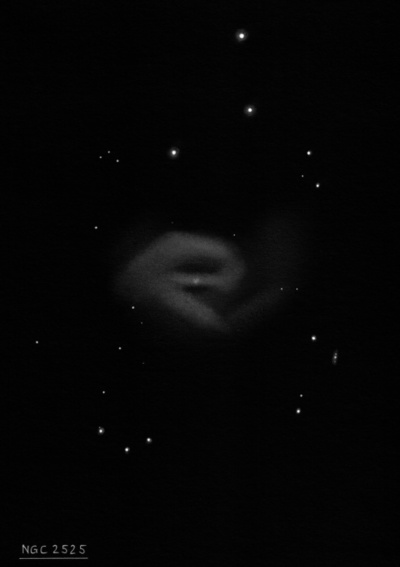
William Herschel discovered NGC 2525 = H III-877 = h486 on 23 Feb 1791 (sweep 995) and recorded "vF, iR, resolvable, about 2' in diameter, almost of equal light throughout." On 9 Mar 1828 (sweep 129), John Herschel wrote, "F; L; R; vgbM; 90"; among stars of the Milky Way."
The galaxy was sketched as a spiral by R.J. Mitchell on 30 Jan 1856, using Lord Rosse's 72". He described "vF, L, oval. Several F stars on edge, suspect others in the neb., also dark spaces. Nucl or * in centre? Spiral as in diagram. A year later he saw additional details: "light very unequal, suspect nucleus and a star close foll nucleus, also star in p edge? Again I though I saw a darkness across np centre [gap in spiral arms] and knots in np edge, but it is very uncertain."
300/350mm - 13.1" (1/11/86): fairly faint, large, slightly elongated E-W, diffuse, weak concentration. Located 3.8' NNE of mag 8.9 SAO 153813 and 6.2' S of mag 8.7 SAO 153816 on the Monoceros border.
600/800mm - 24" (2/8/18 and 2/13/18): at 200x and 375x; fairly bright, fairly large, oval 4:3 ~E-W, broad concentration, no distinct core at 200x but the halo appeared patchy or uneven (brighter and darker regions), strongly hinting at spiral structure. At 375x, a short low contrast central bar (elongated roughly 3:1 E-W) was visible with a slightly brighter nucleus.
13th magnitude SN 2018gv, discovered on Jan 15th, was easily visible at the southwest edge of the galaxy [50" west and 39" south of center]. A mag 14.5 star was easily seen close southwest of the supernova and a very faint and close pair is an additional 20" SW.
Notes by Steve Gottlieb
IC 2375
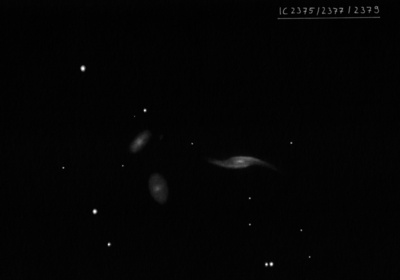
Herbert Howe discovered IC 2375 = Ho I-9, along with IC 2377 and 2379, on 22 Feb 1898 with the 20" refractor at the Chamberlin Observatory in Denver. He noted "F, vS, elongated at 90°, 1st of 3" and his micrometric position matches MCG -02-22-014 = PGC 23672.
400/500mm - 17.5" (2/8/97): first and brightest of a close trio with IC 2377 1.6' E and IC 2379 2.1' ENE. Faint, moderately large, elongated 3:1 E-W, 1.5'x0.5', even surface brightness. The group lies near two mag 11 stars oriented SW-NE.
600/800mm - 24" (2/16/15): first in a striking trio of IC galaxies. At 322x; appeared fairly faint to moderately bright, fairly small, very elongated 7:2 E-W, 0.8'x0.25'. IC 2377 lies 1.6' E and IC 2379 2.1' ENE.
In addition, I picked up MCG -02-22-011 14' SSW (same redshift as triplet; the quartet forming LDCE 574). MCG -02-22-011 was comparable to the ICs and appeared fairly faint, small, elongated 5:3 N-S, ~25"x15", small bright core. A mag 12.3 star is off the southeast side [30" from center].
Notes by Steve Gottlieb
M 3-4
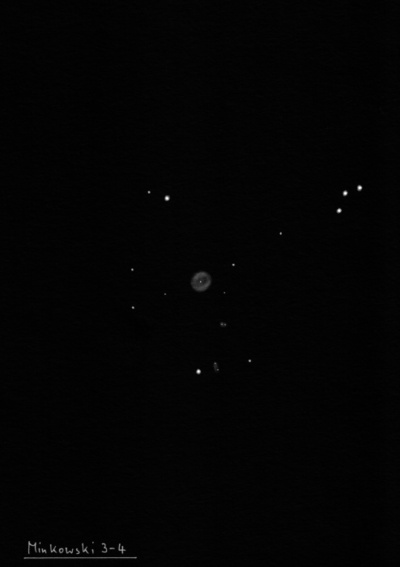
| Type | PN |
| RA | 07:55:11.4 |
| Dec | -23:38:13.0 |
| major_axis | 18.0'' |
| mag | 11.8 |
| surface_bright | 9.1 |
Abell 23
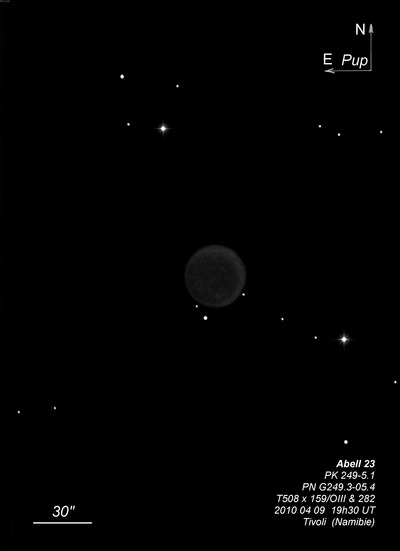
| Type | PN |
| RA | 07:43:18.0 |
| Dec | -34:45:16.0 |
| major_axis | 54.0'' |
| mag | 13.1 |
| surface_bright | 12.6 |
Sa 2-21
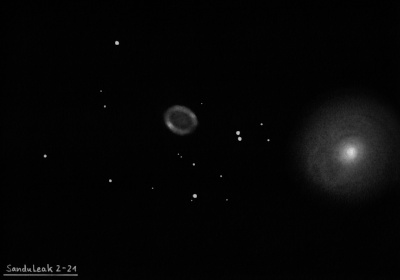
| Type | PN |
| RA | 08:08:44.3 |
| Dec | -19:14:02.0 |
| major_axis | 42.0'' |
| mag | 13.7 |
| surface_bright | 12.6 |
M 1-18
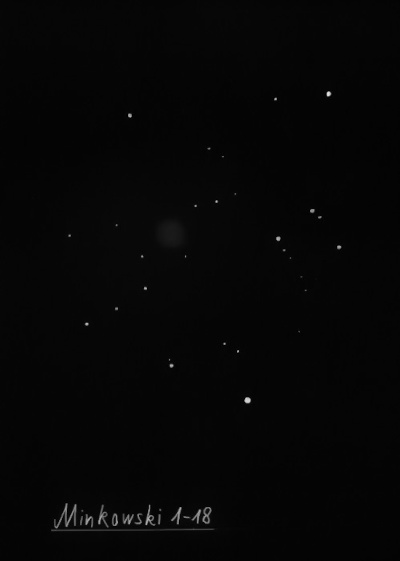
| Type | PN [2b] |
| RA | 07:42:04.2 |
| Dec | -14:21:13.0 |
| major_axis | 36.0'' |
| minor_axis | 30.0'' |
| mag | 14.4 |
| surface_bright | 12.7 |
K 1-12
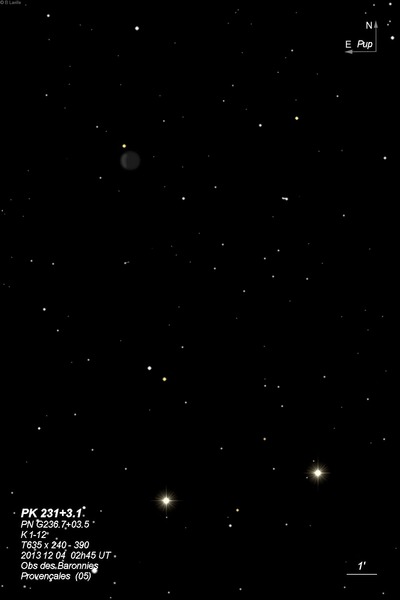
| Type | PN |
| RA | 07:50:11.6 |
| Dec | -19:18:16.0 |
| major_axis | 36.0'' |
| minor_axis | 36.0'' |
| mag | 15.4 |
| surface_bright | 14.1 |